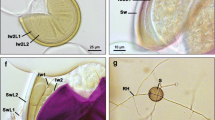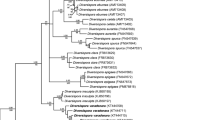Abstract
Morphological studies of spores and mycorrhizal structures and phylogenetic analyses of sequences of the partial small subunit rRNA gene, the whole internal transcribed spacer rDNA region, including the 5.8S rRNA gene, and the partial large subunit rRNA gene of two arbuscular mycorrhizal fungi (Glomeromycota) have indicated that they are undescribed species, one of the genus Acaulospora and the second of Claroideoglomus. The first species, here named A. ignota, is distinguished morphologically by yellow-coloured, relatively small (65–80 μm diam when globose) spores, whose upper surface of the structural laminate spore wall layer is ornamented with inconspicuous warts or flattened elevations, usually deteriorating and disappearing with age. The most distinguishing features of the second species, C. hanlinii, are its relatively small (45–90 μm diam when globose) and dark-coloured (olive yellow) spores, with a simple two-layered spore wall, of which the inner structural laminate layer 2 may be much thicker than that in other known Claroideoglomus species. The occasional pale staining of spore wall layer 1 in Melzer’s reagent is also distinctive in the species. Both species were grown in single-species pot cultures established from spores extracted from pot trap cultures with mixtures of rhizosphere soils and roots of plants colonizing maritime sand dunes near Natal, Brazil (A. ignota), and Varadero, Cuba (C. hanlinii). To date, these are the only sites in the world where these two fungi are known to occur, as confirmed by comparisons of their sequences with those deposited in available databases.




Similar content being viewed by others
References
Ames RN, Schneider RW (1979) Entrophospora, a new genus in the Endogonaceae. Mycotaxon 8:347–352
Becker WN, Gerdemann JW (1977) Glomus etunicatus sp. nov. Mycotaxon 6:29–32
Błaszkowski J (2012) Glomeromycota. W. Szafer Institute of Botany. Polish Academy of Sciences, Kraków
Błaszkowski J, Kovács GM, Gáspár BK, Balázs TK, Buscot F, Ryszka P (2012) The arbuscular mycorrhizal Paraglomus majewskii sp. nov. represents a new distinct basal lineage in Paraglomeraceae (Glomeromycota). Mycologia 104:148–156. doi:10.3852/10-430
Błaszkowski J, Chwat G, Kovács GM, Gáspár BK, Ryszka P, Orłowska E, Pagano MC, Araújo FS, Wubet T, Buscot F (2013) Septoglomus fuscum and S. furcatum, two new species of arbuscular mycorrhizal fungi (Glomeromycota). Mycologia 105:670–680. doi:10.3852/12-127
Błaszkowski J, Chwat G, Góralska A, Bobrowska-Chwat A (2014) Glomus tetrastratosum, a new species of arbuscular mycorrhizal fungi (Glomeromycota). Mycoscience 30:1–7. doi:10.1016/j.myc.2014.08.003
Błaszkowski J, Chwat G, Kovács GM, Ryszka P, Kovács GM (2015) Two new genera, Dominikia and Kamienskia, and D. disticha sp. nov. in Glomeromycota. Nova Hedwigia 100:225–238. doi:10.1127/nova_hedwigia/2014/0216
Brundrett MC (2009) Mycorrhizal associations and other means of nutrition of vascular plants: understanding the global diversity of host plants by resolving conflicting information and developing reliable means of diagnosis. Plant Soil 320:37–77. doi:10.1007/s11104-008-9877-9
Dalpé Y (1989) Inventaire et repartition de la flore endomycorhizienne de dunes et de rivages maritimes du Quebec, du Nouveau-Brunswick et de la Nouvelle-Ecosse. Naturaliste Can (Rev Ecol Syst) 116:219–236
de Mello CMA, da Silva GA, de Assis DMA, de Pontes JS, Ferreira ACA, Leão MPC, Vieira HEE, Maia LC, Oehl F (2013) Paraglomus pernambucanum sp. nov. and Paraglomus bolivianum comb. nov., and biogeographic distribution of Paraglomus and Pacispora. J Appl Bot Food Qual 86:113–125. doi:10.5073/JABFQ.2013.086.016
Gerdemann JW, Trappe JM (1974) The Endogonaceae in the Pacific Northwest. Mycol Mem 5:1–76
Goto BT, Jardim JG, da Silva GA, Furrazola E, Torres-Arias Y, Oehl F (2012) Glomus trufemii (Glomeromycetes), a new sporocarpic species from Brazilian sand dunes. Mycotaxon 120:1–9. doi:10.5248/120.1
Haug I, Setaro S, Suárez JP (2013) Reforestation sites show similar and nested AMF communities to an adjacent pristine forest in a tropical mountain area of South Ecuador. PLoS One 8(3):e6324
Huelsenbeck JP, Ronquist F (2001) MRBAYES: Bayesian inference of phylogeny. Bioinformatics 17:754–755. doi:10.1093/bioinformatics/17.8.754
Kaonongbua W, Morton JB, Bever JD (2010) Taxonomic revision transferring species in Kuklospora to Acaulospora (Glomeromycota) and a description of Acaulospora colliculosa sp. nov. from field collected spores. Mycologia 102:1497–1509. doi:10.3852/10-011
Kornerup A, Wanscher JH (1983) Methuen handbook of colour, 3rd edn. Eyre Methuen, London
Koske RE (1987) Distribution of VA mycorrhizal fungi along a latitudinal temperature gradient. Mycologia 79:55–68. doi:10.2307/3807744
Kottke I, Beck A, Oberwinkler F, Homeier J, Neill D (2004) Arbuscular endomycorrhizas are dominant in the organic soil of a neotropical montane cloud forest. J Trop Ecol 20:125–129. doi:10.1017/S0266467403001020
Krüger M, Stockinger H, Krüger C, Schüßler A (2009) DNA-based species level detection of Glomeromycota: one PCR primer set for all arbuscular mycorrhizal fungi. New Phytol 183:212–223. doi:10.1111/j.1469-8137.2009.02835.x
Krüger M, Krüger C, Walker C, Stockinger H, Schüßler A (2012) Phylogenetic reference data for systematics and phylotaxonomy of arbuscular mycorrhizal fungi from phylum to species level. New Phytol 193:970–984. doi:10.1111/j.1469-8137.2011.03962.x
Lee PJ, Koske RE (1994) Gigaspora gigantea: parasitism of spores by fungi and actinomycetes. Mycol Res 98:458–466. doi:10.1016/S0953-7562(09)81205-7
Nagy LG, Kocsube S, Csana Z, Kovács GM, Petkovits T, Vágvölgyi C, Papp T (2012) Re-mind the gap! insertion – deletion data reveal neglected phylogenetic potential of the nuclear ribosomal internal transcribed spacer (ITS) of fungi. PLoS ONE 7(11):e49794. doi:10.1371/journal.pone.0049794
Nicolson TH, Johnston C (1979) Mycorrhiza in Gramineae. III. Glomus fasciculatum as the endophyte of pioneer grasses in maritime sand dunes. Trans Br Mycol Soc 72:261–268. doi:10.1016/S0007-1536(79)80041-8
Oehl F, da Silva GA, Goto BT, Sieverding E (2011) Glomeromycota: three new genera and glomoid species recognized. Mycotaxon 116:75–120. doi:10.5248/116.75
Oehl F, Castillo C, Schneider D, Säle V, Sieverding E (2012a) Ambispora reticulata, a new species in the Glomeromycota from mountainous areas in Switzerland and Chile. J Appl Bot Food Qual 85:129–133
Oehl F, Palenzuela J, Sánchez-Castro I, Kuss P, Sieverding E, Oehl F, Palenzuela J, Iván Sánchez-Castro I, Hountondji F, Tchabi A, Lawouin L (2012b) Acaulospora nivalis, a new fungus in the Glomeromycetes, characteristic for high alpine and nival altitudes of the Swiss Alps. Nova Hedwigia 85:105–122. doi:10.1127/0029-5035/2012/0038
Ohsowski BM, Zaitsoff PD, Öpik M, Miranda M, Hart MM (2014) Where the wild things are: looking for uncultured Glomeromycota. New Phytol 204:171–179. doi:10.1111/nph.12894
Omar MB, Bollan L, Heather WA (1979) A permanent mounting medium for fungi. Bull Br Mycol Soc 13:31–32. doi:10.1016/S0007-1528(79)80038-3
Pyrozinski KA, Malloch DW (1975) The origin of land plants: a matter of mycotrophiphism. Biosystems 6:153–164. doi:10.1016/0303-2647(75)90023-4
Redecker D, Kodner R, Graham LE (2000) Glomalean fungi from the Ordovician. Science 289:1920–1921. doi:10.1126/science.289.5486.1920
Redecker D, Schüβler A, Stockinger H, Stürmer SL, Morton JB, Walker C (2013) An evidence-based consensus for the classification of arbuscular mycorrhizal fungi (Glomeromycota). Mycorrhiza 23:515–531. doi:10.1007/s00572-013-0486-y
Ricardo-Nápoles NE, Herrera OPP (2011) Diversity of Cayuelo Grande and Canal de Manuey, Península de Hicacos, Matanzas, Cuba. Acta Bot Cuba 211:19–28
Ronquist F, Huelsenbeck JP (2003) MRBAYES 3: Bayesian phylogenetic inference under mixed models. Bioinformatics 19:1572–1574. doi:10.1093/bioinformatics/bgt180
Schenck NC, Spain JL, Howeler RH (1984) Several new and unreported vesicular-arbuscular mycorrhizal fungi (Endogonaceae) from Colombia. Mycologia 76:685–699. doi:10.2307/3793226
Schüßler A, Walker C (2010) The Glomeromycota. A species list with new families and new genera. Royal Botanic Garden Edinburgh, Gloucester. doi:10.5248/116.75
Silvestro D, Michalak I (2012) raxmlGUI: a graphical front-end for RAxML. Org Divers Evol 12:335–337. doi:10.1007/s13127-011-0056-0
Simmons MP, Ochoterena H, Carr TG (2001) Incorporation, relative homoplasy, and effect of gap characters in sequence-based phylogenetic analyses. Syst Biol 50:454–462. doi:10.1080/106351501300318049
Smith SE, Read DJ (2008) Mycorrhizal symbiosis, 3rd edn. Academic Press, San Diego
Sridhar KR, Beena KR (2001) Arbuscular mycorrhizal research in coastal sand dunes: a review. Proc Nat Acad Sci India 71:179–205
Stamatakis A (2014) RAxML Version 8: a tool for phylogenetic analysis and post-analysis of large phylogenies. Bioinformatics, (online early), doi:10.1093/bioinformatics/btu033
Stockinger H, Krüger M, Schüßler A (2010) DNA barcoding of arbuscular mycorrhizal fungi. New Phytol 187:461–474. doi:10.1111/j.1469-8137.2010.03262.x
Stürmer SL, Morton JB (1997) Developmental patterns defining morphological characters in spores of four species in Glomus. Mycologia 89:72–81. doi:10.5248/116.75
Stürmer SL, Morton JB (1999) Taxonomic reinterpretation of morphological characters in Acaulosporaceae based on developmental patterns. Mycologia 91:849–857. doi:10.2307/3761538
Tadych M, Błaszkowski J (2000) Arbuscular fungi and mycorrhizae (Glomales) of the Słowiński National Park, Poland. Mycotaxon 74:463–483
Tamura K, Peterson D, Peterson N, Stecher G, Nei M, Kumar S (2011) MEGA5: Molecular Evolutionary Genetics Analysis using Maximum Likelihood, Evolutionary Distance, and Maximum Parsimony Methods. Mol Biol Evol 28:2731–2739. doi:10.1093/molbev/msr121
Walker C (1983) Taxonomic concepts in the Endogonaceae: spore wall characteristics in species descriptions. Mycotaxon 18:443–455
Walker C, Pfeiffer CM, Bloss HE (1986) Acaulospora delicata sp. nov. – an endomycorrhizal fungus from Arizona. Mycotaxon 25:621–628
Young ND, Healy J (2003) GapCoder automates the use of indel characters in phylogenetic analysis. BMC Bioinforma 4:6. doi:10.1186/1471-2105-4-6
Zhang Z, Schwartz S, Wagner L, Miller W (2000) A greedy algorithm for aligning DNA sequences. J Comput Biol 7:203–214. doi:10.1089/10665270050081478
Zobel M, Öpik M (2014) Plant and arbuscular mycorrhizal fungal (AMF) communities – which drives which? J Veg Sci 25:1133–1140. doi:10.1111/jvs.12191
Acknowledgments
This study was supported in part by Polish National Centre of Science grants no. 2012/05/B/NZ8/00498 and 2012/07/N/NZ8/02363. We thank anonymous reviewers and Dr. F. Oberwinkler, Editor-in-Chief of Mycological Progress, for valuable comments.
Author information
Authors and Affiliations
Corresponding author
Rights and permissions
About this article
Cite this article
Błaszkowski, J., Chwat, G. & Góralska, A. Acaulospora ignota and Claroideoglomus hanlinii, two new species of arbuscular mycorrhizal fungi (Glomeromycota) from Brazil and Cuba. Mycol Progress 14, 18 (2015). https://doi.org/10.1007/s11557-015-1042-2
Received:
Revised:
Accepted:
Published:
DOI: https://doi.org/10.1007/s11557-015-1042-2




